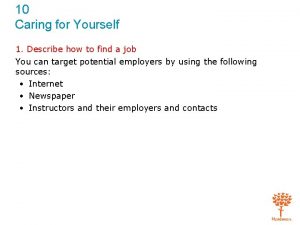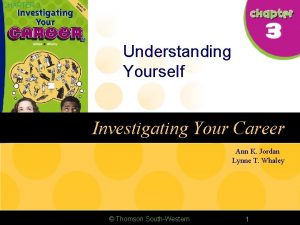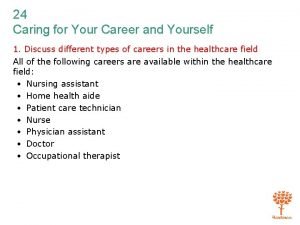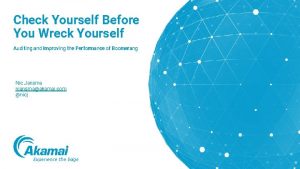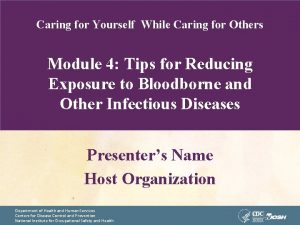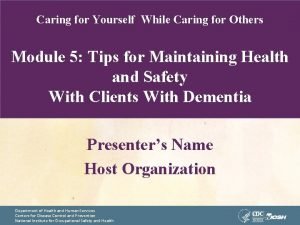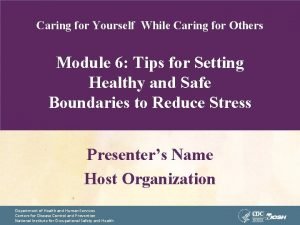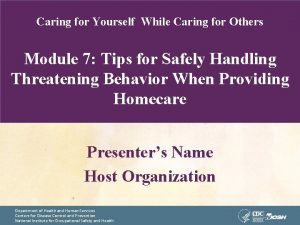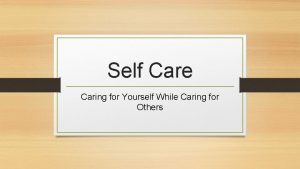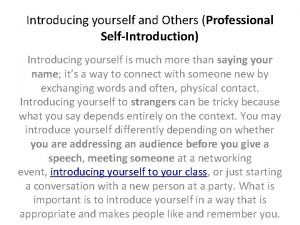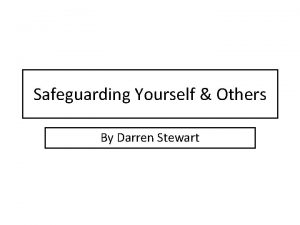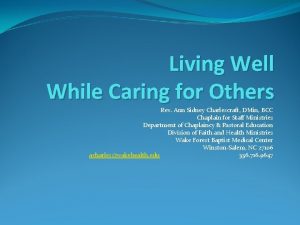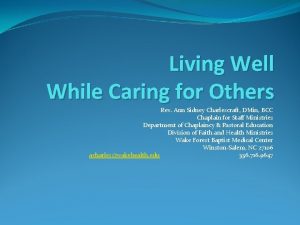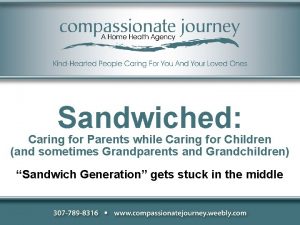Caring for Yourself While Caring for Others Module

















![Credits • [Insert trainer and/or training organization’s name(s), and contact information here. ] Department Credits • [Insert trainer and/or training organization’s name(s), and contact information here. ] Department](https://slidetodoc.com/presentation_image_h/90ad14bda2ba9fd9071ad538246dd2b1/image-18.jpg)
- Slides: 18

Caring for Yourself While Caring for Others Module 1: An Introduction to Homecare Health and Safety Presenter’s Name Host Organization Department of Health and Human Services Centers for Disease Control and Prevention National Institute for Occupational Safety and Health

Department of Health and Human Services Centers for Disease Control and Prevention National Institute for Occupational Safety and Health

Welcome and Introductions Please tell us • Your name. • Your role in homecare. • What body parts are strained by the work you do? Department of Health and Human Services Centers for Disease Control and Prevention National Institute for Occupational Safety and Health Photo by ®Thinkstock • How long have you worked in homecare?

Four Areas of Risk in Homecare 1. Muscle and bone injuries, and strain. 2. Exposure risks. 4. Emergency and personal safety. Department of Health and Human Services Centers for Disease Control and Prevention National Institute for Occupational Safety and Health Photo by ®Thinkstock 3. Emotional and mental stress.

• Transferring clients. • Carrying heavy loads, such as laundry, equipment, or other heavy items. • Moving clients in bed. • Lifting or moving furniture or other heavy objects. • Bending and stretching while cleaning or helping clients with activities of daily living. • Tripping in the home or walkways up to the home. Department of Health and Human Services Centers for Disease Control and Prevention National Institute for Occupational Safety and Health Photo by ®Thinkstock Muscle/Bone Injuries and Strains

• • • Airborne germs. Body fluids. Needlesticks or sharps wounds. Cleaning agents. Pets. Latex. Second-hand smoke. Infestations of bugs. Too hot or cold temperatures. Department of Health and Human Services Centers for Disease Control and Prevention National Institute for Occupational Safety and Health Photo by ®Thinkstock Exposure Risks

Emotional and Mental Stresses • Working many hours, trying to do too much in too little time. • Abusive and challenging interactions with clients or others in homes, and in personal life. • Life stresses—finances, health, housing, transportation, childcare, or relationships. Department of Health and Human Services Centers for Disease Control and Prevention National Institute for Occupational Safety and Health Illustration by ®Mary Ann Zapalac • Grief related to clients or loved ones.

Emergency and Personal Safety • Fire, tornadoes, floods, hurricanes, electrical outages, and other events while at work. • Dangers in the areas around homes. • Violence in the homes. Department of Health and Human Services Centers for Disease Control and Prevention National Institute for Occupational Safety and Health Photo by ®Thinkstock • Driving to and from work.

Health and Safety is So Important Because … • If you get injured or ill, you miss work, you lose income, and you can leave clients without support. • Clients often worry about you when you are hurt. Department of Health and Human Services Centers for Disease Control and Prevention National Institute for Occupational Safety and Health Photo by ®Thinkstock • Strained backs and muscles create more risk of hurting clients.

Healthy and Safety is Also Important Because • Getting injured or ill affects all aspects of your life. • If you are sick, you can infect clients and others. Department of Health and Human Services Centers for Disease Control and Prevention National Institute for Occupational Safety and Health Photo by ®Thinkstock • It’s painful—and stressful— to be sick, or to have sprains, strains, and broken bones.

Homecare Workers May Put Their Health and Safety at Risk Because … • They don’t want to let clients down and need their wages, so they work when hurt or sick. • They haven’t received training — or haven’t been trained enough —to know how to maintain their health and safety. Department of Health and Human Services Centers for Disease Control and Prevention National Institute for Occupational Safety and Health Photo by ®Thinkstock • They hurry—trying to do too much in too little time.

Workers’ Health and Safety May Also Be Put at Risk Because … • They put doing what clients want and need over their own health and safety. • Clients want them to do things that aren’t safe or treat them in ways that are stressful, and they haven’t learned how to set healthy boundaries. Department of Health and Human Services Centers for Disease Control and Prevention National Institute for Occupational Safety and Health

Tips for Staying Healthy and Safe on the Job • Stay alert and get training (and never stop learning) about the four areas of risk: — Physical strains. — Exposures. — Stresses. — Physical and emergency safety. • Speak up and listen constructively—out of respect for yourself and with respect for others. Talk with clients and supervisors to address concerns. Department of Health and Human Services Centers for Disease Control and Prevention National Institute for Occupational Safety and Health

More Health and Safety Strategies… • Use assistive devices if available—ask for them and help select them, if possible. • Use Standard Precautions—especially gloves and hand-washing—to avoid exposures. • Use approved containers for disposing of sharps and needles. • Report concerns to clients and management immediately. Department of Health and Human Services Centers for Disease Control and Prevention National Institute for Occupational Safety and Health Photo by ®Thinkstock • Learn and use good body mechanics.

Take Care of Yourself • Get sleep, exercise, and follow a healthy diet. • Take time weekly to plan and care for your own well-being. • Engage others in your life in helping you address stress—talk it over assertively. Department of Health and Human Services Centers for Disease Control and Prevention National Institute for Occupational Safety and Health Illustration by ®Mary Ann Zapalac • Drive safely with your seat belt on, with no phones or distractions.

Talk it Over! Bring up health and safety issues as soon as possible. • Plan the discussion. • Be respectful—make a request, not a demand. • Use “I” statements. Describe what you observe and how it affects you rather than blaming the other. • Listen and see the issue from the other’s point of view. • Consider several solutions beyond your first choice. • Know your bottom line. Department of Health and Human Services Centers for Disease Control and Prevention National Institute for Occupational Safety and Health

Thanks for participating! Additional Resources: • Homecare workers’ handbook: Caring for Yourself While Caring for Others. http: //www. cdc. gov/niosh/docs/2015 -103/pdf/2015 -103. pdf • NIOSH Hazard Review: “Occupational Hazards and Home Health Care. ” http: //www. cdc. gov/niosh/docs/2010 -125/pdfs/2010125. pdf Department of Health and Human Services Centers for Disease Control and Prevention National Institute for Occupational Safety and Health
![Credits Insert trainer andor training organizations names and contact information here Department Credits • [Insert trainer and/or training organization’s name(s), and contact information here. ] Department](https://slidetodoc.com/presentation_image_h/90ad14bda2ba9fd9071ad538246dd2b1/image-18.jpg)
Credits • [Insert trainer and/or training organization’s name(s), and contact information here. ] Department of Health and Human Services Centers for Disease Control and Prevention National Institute for Occupational Safety and Health
 Jean watson theory
Jean watson theory Cna chapter 10 caring for yourself
Cna chapter 10 caring for yourself Chapter 24 caring for your career and yourself
Chapter 24 caring for your career and yourself Chapter 31 caring for your career and yourself
Chapter 31 caring for your career and yourself Chapter 6 lesson 2 respecting yourself and others
Chapter 6 lesson 2 respecting yourself and others Motivating yourself and others
Motivating yourself and others Youtube yourself broadcast yourself
Youtube yourself broadcast yourself Know yourself to lead yourself
Know yourself to lead yourself Check yourself before you wreck yourself origin
Check yourself before you wreck yourself origin Myself themselves yourselves
Myself themselves yourselves Why are some countries rich and others poor
Why are some countries rich and others poor While do loop
While do loop C device module module 1
C device module module 1 Texter för hinduer tantra
Texter för hinduer tantra Centrum för kunskap och säkerhet
Centrum för kunskap och säkerhet Påbyggnader för flakfordon
Påbyggnader för flakfordon Jag har gått inunder stjärnor text
Jag har gått inunder stjärnor text Inköpsprocessen steg för steg
Inköpsprocessen steg för steg Sura för anatom
Sura för anatom

